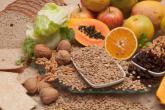Introduction
Functions of proteins
Nutritional requirements
Complete protein
Classification of proteins, sources
Interesting facts
Introduction
Proteins are fundamental elements of build of all tissues of human's body and of many compounds such as: enzymes, hormones, antibodies. Proteins regulate processes of metabolism and many body functions, ensuring their correct state and functioning of our body. Appropriate amounts of proteins decide about normal human's growth, regeneration of expelled or damaged tissues. Proteins are multi-molecular compounds built of amino acids. There are about
22 amino acids, and 8 among them, called indispensable or essential, are included in protein of animal origin which we consume in food. Only some food of plant origin contains the 8 essential amino acids, that is why so relevant is the variety of consumed nourishment.
|
|
|
Functions of proteins
-
proteins are essential material for building new and reconstruction of used tissues. They occupy the first place among solid ingredients of body-they state 75% of dry matter of soft body tissue,
-
proteins not used for anabolism are the energy source: combustion of 1 g of protein releases 4 kcal of energy,
-
proteins are basic ingredient of body liquids: blood, lymph, milk,
-
organism uses proteins to create protein parts of digesting and tissue enzymes. Shortage of proteins in a diet reverberates after a few days in quantity and activity of enzymes,
-
proteins are the material for biosynthesis of protein hormones,
-
proteins are the material for biosynthesis of antibodies,
-
proteins participate in detoxication of organism.
Nutritional requirements
Proteins should provide 10-35% of energetic value of daily nutritious ration for an adult. It ought to be balanced proteins containing the 8 essential amino acids.
RDA for various life stage groups
| Life stage group | Proteins | |
|---|---|---|
|
Recommended Dietary Allowances (RDA)*1 [g/day] |
Acceptable Macronutrient Distribution Range (AMDR)*2 [%] |
|
| Infants 0-6 months | 9,1 | ND |
| Infants 6-12 months | 11 | ND |
| Children 1-3 years | 13 | 5-20 |
| Children 4-8 years | 19 | 10-30 |
| Males 9-13 years | 34 | 10-30 |
| Males 14-18 years | 52 | 10-30 |
| Males 19-30 years | 56 | 10-35 |
| Males 31-50 years | 56 | 10-35 |
| Males 51-70 years | 56 | 10-35 |
| Males > 70 years | 56 | 10-35 |
| Females 9-13 years | 34 | 10-30 |
| Females 14-18 years | 46 | 10-30 |
| Females 19-30 years | 46 | 10-35 |
| Females 31-50 years | 46 | 10-35 |
| Females 51-70 years | 46 | 10-35 |
| Females > 70 years | 46 | 10-35 |
| Pregnancy ? 18 years | 71 | 10-35 |
| Pregnancy 19-30 years | 71 | 10-35 |
| Pregnancy 31-50 years | 71 | 10-35 |
| Lactation ? 18 years | 71 | 10-35 |
| Lactation 19-30 years | 71 | 10-35 |
| Lactation 31-50 years | 71 | 10-35 |
*1 Based on 1,5 g/kg/day for infants, 1,1 g/kg/day for 1-3 years, 0,95 g/kg/day for 4-13 years, 0,85 g/kg/day for 14-18 years, 0,8 g /kg/day for adults, and 1,1 g/kg/day for pregnant (using pre-pregnancy weight) and lactating women.
*2 Acceptable Macronutrient Distribution Range (AMDR) is the range of intake for a particular energy source that is associated with reduced risk of chronic disease while providing intakes of essential nutrients. If an individuals consumed in excess of the AMDR, there is a potential of increasing the risk of chronic diseases and insufficient intakes of essential nutrients.
ND = Not determinable due to lack of data of adverse effects in this age group and concern with regard to lack of ability to handle excess amounts. Source of intake should be from food only to prevent high levels of intake.
Complete protein
It consists of all 8 essential amino acids, in suitable proportion. Such proteins are shortly absorbed in organism and effectively used. Proteins occurring in nourishment of animal origin stand out larger biological value than plant proteins, lacking one or several essential amino acids. An egg white is believed to be the optimum in terms of amino acid composition. Absence of at least a single one
indispensable amino acid determines the lack of possibility of protein absorption. To make meals balanced one should match products consisting of part value or not
complete protein.
Indispensable amino acids (essential):
-
valine
-
leucine
-
isoleucine
-
threonine
-
methionine + cysteine
-
phenylalanine + tyrosine
-
tryptophan
-
lysine
-
histidine (essential for infants and children)
Dispensable amino acids (non-essential):
-
alanine
-
arginine
-
glycine
-
asparagine
-
aspartic acid
-
glutamic acid
-
glutamine
-
cystine
-
proline
-
ornithine
-
serine
Classification of proteins, food sources
Proteins are divided into simple proteins and conjugated proteins
Simple proteins
Conjugated proteins
Albumins
Proteins soluble in water and dilute salt solutions. Widely spread in nature: they are in blood serum, lymph, milk, eggs, muscles of vertebrates (myoalbumin, myogen), seeds of pod plants
(legumelin in green pea) and cereals (leucosine in barley, rye and wheat).
Globulins
Proteins insoluble in pure water but they dissolve in dilute inert salt solutions. They very easily get denaturated. Blood serum globulins, milk globulin, plasma fibrinogen, muscle myosin, thyroglobulin (thyroid gland hormone),
tuberin (from potato) belong to these proteins. To globulins also belong immunity cells (immunoglobulins).
Glutelins
Soluble in dilute solutions of acids and bases, and insoluble in water and salt solutions. They contain significant amounts of amino acid - glutamic acid, glutamine and proline. They occur in seeds of dicotyledons, but in highest amounts in cereal grains (glutelin in wheat).
Prolamines
Prolamins are also called gliadins. They dissolve in 70-80% of alcohols. They occur only in cereal grains.
Scleroproteins
They occur only in animal organisms, mainly in supporting and protective tissues. First of all here belong proteins of connective tissue (collagen, elastin), hair and horny parts (keratin). They dissolve neither in water nor in dilute solutions of acids and lyes. Scleroproteins are resistant to the action of proteolistic enzymes of human's digestive system.
Histones
Alkaline proteins of nuclei in which they occur in connection with nucleic acids, forming nucleoproteins. Histones are well soluble in water and dilute solutions of acids.
Protamines
Strongly alkaline proteins. They occur in fish sperm where they form connections with nucleic acids. They do not contain sulfuric amino acids (methionine, cysteine), are well soluble in solutions of acids.
Chromoproteins
Consisted of simple proteins and prosthetic group - dye. Hemoproteins (hemoglobin, myoglobin, cytochromes, catalase, peroxidase) containing heme system and flavoproteins belong to them.
Phosphoproteins
They contain about 1% of phosphorus in form of phosphoric acid radicals. Milk casein, egg yolk
vitellin and spawn ichthyoline belong to these proteins.
Nucleoproteins
They consist of alkaline proteins and nucleids acids. Ribonucleoproteins are mainly located in cytoplasm: in ribosomes, microsomes and mitochondria, in small amount also in nuclei, and beyond nucleus only in mitochondria. Viruses are built almost only from nucleoproteins.
Lipoproteins
Connection of proteins with simple or complex fats, steroids. Lipoproteins are cholesterol (LDL, HDL, VLDL) carriers.
Glycoproteins
Sugars constitute prosthetic group, inter alia mucopolysaccharides (saliva)
belong to them. Glycoproteins also occur in eye substance and fluid of articular
capsules.
Metalloproteins
They contain metal atoms (copper, zinc, iron, calcium, magnesium) as prosthetic group. Metal atoms constitute active group of many enzymes.
Interesting facts
-
high consumption of proteins leads to bigger calcium losses,
-
vegetables contain much water, in consequence they take much room in digestive system. With relatively low protein content they are not relevant source of amino acids,
-
low protein content in a diet leads to malnutrition - a state which slows down the process of organism growth, muscle build, energy reserves accumulation, disturbances in bowel running (absorption handicap) and increase of risk of infecting diseases and sometimes allergy,
-
cereals are relatively poor in protein (8-14%) in comparison to other products from our diet. They are rich in very valuable sulphuric amino acids (their composition contains sulphur) but on the other hand they are deficient in lysine - an amino acid essential for correct growth of babies and children. However, because of high level of consumption of cereal products, their participation in recommended intake of protein is very important,
-
connection of cereal products with pod or milk ones in one meal may cover the demand for essential amino acids. It is very important, because such connections of products are recommended as the example in developed countries (e.g. cereal + milk) and in developing ones (soybean + rice, soybean + sweat corn, bean + wheat),
-
when human's body loses more than 14% of total protein amount in organism, it leads to serious disorders, what realizes us the relevance of this nutrient in a diet. Only water is more relevant than protein for our life (loss of just 8% of water may turn disastrous in results). The opposite to such losses and consequences for human's life is fat, because loss even up to 90% of fat tissue may affect our health only marginally,
-
the sources of animal protein occur in products always in connection with animal fat (e.g. meat, cheese) and due to it, this kind of nutritious protein tends to increase the level of cholesterol in blood and rise cholesterol production by organism. The reason of that state are fats rich in saturated fat acids, which are for instance responsible for the production of bad cholesterol,
-
products rich in animal proteins are frequently the carriers of different mineral constituents e.g. calcium in milk, iron and zinc in red meat,
-
seeds of leguminous plants are rich in protein (25-40%), but its amino acid composition is not so good as in amino acid protein (they contain little amino acids so-called sulphuric). The exception constitutes soybean. However, the connection of seeds of pod and cereal plants in a diet may provide appropriate amount of all amino acids essential to correct growth of organism and upkeep of health,
-
nuts contain much proteins. They are consumed in too little quantities and that is why they are not perceived as its important source.

















